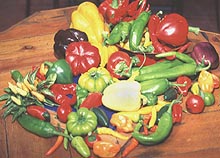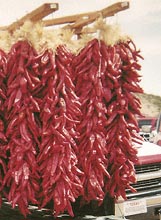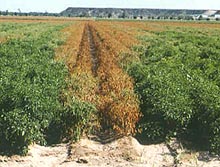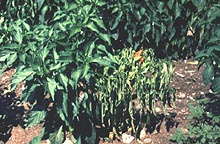Peer-Reviewed by Plant Health Progress
Accepted for publication 18 April 2003. © 2003 Plant Management Network.
Soum Sanogo, Department of Entomology, Plant Pathology, and Weed Science, N141 Skeen Hall, MSC 3BE, New Mexico State University, Las Cruces 88003
Corresponding author: Soum Sanogo. ssanogo@nmsu.edu
Sanogo, S. 2003. Chile pepper and the threat of wilt diseases. Online. Plant Health Progress doi:10.1094/PHP-2003-0430-01-RV.

Chile, chili, and chilli; which is which? The literature on “peppers” contains a confusing labyrinth of names with various derivations and slight nuances of meaning. Etymologically, the word “chile” is derived from the Aztec language, and refers to Capsicum peppers in Central America including Mexico, and in several parts of southwestern United States (18). The word “chili” is thought to be the anglicized form of “chile” and now denominates pungent types of Capsicum peppers in the United States. Similarly, the words “chilli” (singular form) or “chillies” (plural form) are used in Middle Eastern and Asian countries in connection with pungent forms. In 1983, Senator Domenici from New Mexico introduced a bill to formalize the word “chile” as the correct way of spelling Capsicum pepper (7). According to Bosland and Votava (5), a “chile powder” contains ground fruit of Capsicum plant, whereas “chili powder” would contain a mixture of chile powder with one or more of other ingredients such as onion and garlic.
Chile is an important vegetable and spice crop worldwide that is produced and consumed as fresh or processed (Fig. 1). The pool of all chile cultivars comes from five species of the genus Capsicum: C. annuum, C. chinense, C. baccatum, C. frutescens, and C. pubescens (5,18). Several sources concordantly put the origin of chile pepper in Bolivia or Brazil (1,13). From these centers of origin, the chile pepper was brought to Central and North America, Asia, Africa, and Europe through several avenues such as discovery travels by explorers and traders.
|

Fig. 1. Diversity of shape, size, and color of chile pods (Courtesy P. Bosland). |
|
Classification of chile varieties has been a challenge ever since Columbus’s passage in the Americas. The two features commonly used in the classification are pod types (shape, size, color, and texture) as shown in Fig. 1, and pungency (5,18). Pungency in chile is due to the presence of capsaicinoids in the pod, and is measured based on Scoville heat index (16). Examples of common pod types are bell, cayenne, jalapeño, tabasco, aji amarillo, and manzano. Examples of pungent cultivars are found in the groups of jalapeño, cayenne, serrano, and ancho. Detailed listing of pod types and pungent varieties is provided by Bosland and Votava (5).
Today, chile is found throughout the world and plays a significant socio-economic role. Major producers of chile include Asia, Latin America, Africa, Europe, and North America (2). Within the United States, New Mexico is the leading producer of chile followed by California, Texas, Arizona, and North Carolina (3). In 2003, the value of US chile production was about $84 million, of which $52 million were contributed by chile produced in New Mexico. Paterson (13) provides a detailed historical account of chile production in the US. Chile production peaked in Louisiana in the second half of the 19th century with the cultivation of the tabasco type, which was processed into hot sauce, and marked the beginning of the hot sauce industry. Besides Louisiana, chile pepper cultivation boomed in California. However, owing to pressures from plant pests and diseases, unfavorable economic forces, and urbanization, production later shifted to New Mexico (13).
Chile has become ingrained in several socio-economic fabrics within the US and worldwide. The increasing interest in chile emanates from increasing awareness of its nutritional value, medicinal properties, industrial and ornamental characteristics. Chile is a source of vitamins (A, B1, B2, B3, C, and E), carotenoids, and capsaicinoids. Relief or cures from more than a dozen ailments including the common cold, headache, and toothache have been ascribed to the use of chile. Capsaicin, a type of capsaicinoid, is used in pomade to soothe pains from arthritis. Owing to the vividness of pod color, potted ornamental chile comprises a growing sector within the chile industry (4).
The socio-cultural role of chile is remarkable worldwide, especially in the southwestern US. Each year, on Labor Day weekend, New Mexico celebrates the Chile Festival, an event with a national and international attraction. The event takes place in the village of Hatch in southern New Mexico. At center stage of the celebration are displays of a wide array of chile pods from various cultivars attached in strings known as ristras that are hung on various types of support (Fig. 2). In addition, a consortium of chile-based dishes and roasted chile (Fig. 3) are sold for the delight of visitors. Besides New Mexico, chile is celebrated during the Chile and Frijoles Festival in September in the city of Pueblo, Colorado, and during the Jalapeño Festival in February in Laredo, Texas.
| |
 |
|
 |
|
Fig. 2. Hanging ristras at the Chile Festival in Hatch, New Mexico. |
|
Fig. 3. A chile pod roaster at the Chile Festival in Hatch, New Mexico. |
The popularity and demand for chile are providing a boost to the chile industry, but production is increasingly constrained by chile plant diseases. The prevalence of diseases varies geographically. In southern New Mexico, 43% of chile producers reported wilt as the most frequently encountered disease problem (17). Several microorganisms may be involved in causing wilt diseases in chile. This article briefly describes four diseases that lead to wilting in chile: Phytophthora root rot, Verticillium wilt, Rhizoctonia root rot, and Fusarium wilt.
Phytophthora root rot is caused by the fungus-like organism Phytophthora capsici, which was first described in 1922 in New Mexico (11). Infection of the root and lower portion of the stem (Fig. 4) leads to plant wilting (Fig. 5), which is the most conspicuous symptom of the disease. In furrow-irrigated fields, there is a row-delimited pattern of wilted plants (Fig. 6). Over time, wilting is displayed over the entire field. Phytophthora capsici produces specialized swimming cells, known as zoospores, which enable spread of the pathogen from plant to plant. Management of P. capsici consists of reducing soil water saturation; using resistant cultivars if available; reducing populations of the pathogen through crop rotation, soil solarization, and application of organic amendments; and restricting pathogen dispersal through mulching and judicious use of fungicides such as metalaxyl and mefenoxam (14).
|
 |
|
 |
|
|
Fig. 4. Blackening of chile plant root that is severely affected by Phytophthora root rot (Courtesy D. Lindsey). |
|
Fig. 5. A chile plant wilted as a result of root rot caused by Phytophthora capsici (Courtesy D. Lindsey). |
|
| |

Fig. 6. A chile field with plants affected by Phytophthora root rot (Courtesy D. Lindsey). |
|
Verticillium wilt of chile is caused by Verticillium dahliae and V. albo-atrum. Visual symptoms of the disease include stunting, defoliation, and wilting, with discoloration of the vascular system. In the field, the disease first appears in a single plant or a small group of wilting plants (foci) scattered throughout the field (Figs. 7 and 8), depending on the distribution of the pathogen in soil. The disease gradually spreads from these foci, and this expansion may cover the entire area of plantings. Infected plants may exhibit physiological changes such as reduction in photosynthesis, increased plant transpiration, and respiration. Although tremendous effort has been made to identify resistance to Verticillium wilt, currently there are no commercially-acceptable cultivars that are genetically resistant to this disease. Application of chloropicrin and metam-sodium fumigants, and use of organic amendments (9), may decrease Verticillium wilt through reduction of pathogen populations in soil.
 |
|
 |
|
Fig. 7. Early stage of Verticillium wilt in a chile plant. Note the slight yellowing of leaves of the affected plant in contrast to the bright green foliage of healthy surrounding plants (Courtesy D. Lindsey). |
|
Fig. 8. Scattered plants affected by Verticillium wilt in a furrow-irrigated chile field (Courtesy D. Lindsey). |

Fig. 9. A chile plant infected by Rhizoctonia solani, with a reddish-brown discoloration at the soil line level of the stem (Courtesy P. Bosland). |
|
Rhizoctonia root rot caused by Rhizoctonia solani generally affects seedlings. But, R. solani can also infect mature plants and induce root rot (Fig. 9), which leads to wilting and death of chile plants. Rhizoctonia solani persists in soils and organic debris. Several chile accessions belonging to four Capsicum species were evaluated by Muhyi and Bosland (12) for resistance to R. solani. To date, there are no commercially-acceptable chile cultivars that are resistant to R. solani. Management of this fungal pathogen relies on using high-quality seed treated with fungicides such as thiram or captan, and avoiding saturated soil conditions. In fields with high pathogen populations, control measures may include the use of soil fumigants and soil solarization.
In 1919, Leonian (10) described a wilt disease of chile caused by Fusarium annuum, and at that time the disease was apparently present only in New Mexico. The only other work supporting the association of F. annuum with chile wilt was done by Crawford (6) and reported in 1934. Since then, there has been no further report of the occurrence of Fusarium wilt in New Mexico. Fusarium annuum is apparently synonymous with F. oxysporum (8), and recently a new form of F. oxysporum has been identified in Louisiana as being pathogenic only on tabasco pepper and other Capsicum species (15) and nonpathogenic to cotton, cantaloupe, cucumber, eggplant, okra, watermelon, and tomato. Symptoms include leaf chlorosis, vascular discoloration, and wilting of chile pepper plants. High temperature and high moisture are conducive to symptom development. Reducing saturated conditions in soil is an important step in managing the disease. If economically justified, soil fumigants and solarization may be used to reduce pathogen populations in soil.
Collectively, the diseases described above have a significant impact on chile production and present a formidable challenge for chile producers. The successful management of these wilt diseases will be vital to ensure the future economic viability of chile production and the continued uses of chile for culinary and socio-cultural purposes.
Additional Resources
Chile Pepper Institute
USDA Crop Profiles
World Vegetable Center
Literature Cited
1. Andrews, J. 1984. Peppers: The Domesticated Capsicums. University of Texas Press, Austin, Texas.
2. Anonymous. 2003. Major food and agricultural commodities and producers: Countries by commodity. Online. Food and Agriculture Organization of the United Nations, Economic and Social Department, Statistics Division.
3. Anonymous. 2003. Vegetables: Annual summary. Online. United States Department of Agriculture, National Agricultural Statistics Service, Vg 1-2 (03).
4. Armitage, A., and Hamilton, B. 1987. Ornamental peppers: A hot new crop. Greenhouse Grower 5:92-95.
5. Bosland, P. W., and Votava, E. J. 2000. Peppers: Vegetable and Spice Capsicums. Crop Production Science in Horticulture Series No. 12. CABI Publishing, United Kingdom.
6. Crawford, R. F. 1934. The etiology and control of chile wilt, produced by Fusarium annuum. NM Agric. Exp. Sta. Tech. Bull. 223.
7. Domenici, P. 1983. The correct way to spell chile. Congress. Rec. 129:149.
8. Farr, D. F., Bills, G. F., Chamuris, G. P., and Rossman, A. Y. 1989. Fungi on Plants and Plant Products in the United States. American Phytopathological Society, St. Paul, MN.
9. Lazarovits, G., Conn, K., and Tenuta, M. 2000. Control of Verticillium dahliae with soil amendments: Efficacy and mode of action. Pages 274-291 in: Advances in Verticillium Research and Disease Mangement. E. C. Tjamos, R. C. Rowe, J. B. Heale, and D. R. Fravel, eds. American Phytopathological Society, St. Paul, MN.
10. Leonian, L. H. 1919. Fusarium wilt of chile pepper. NM Agric. Exp. Sta. Tech. Bull. 121.
11. Leonian, L. H. 1922. Stem and fruit blight of chiles caused by Phytophthora capsici sp. nov. Phytopathology 12:401-408.
12. Muhyi, R., and Bosland, P. W. 1992. Evaluation of Capsicum germplasm for sources of resistance to Rhizoctonia solani. HortScience 30:341-342.
13. Paterson, K. I. 2000. The Hot Empire of Chile. Bilingual Press, Temple, AZ.
14. Ristaino, J. B., and Johnston, S. A. 1999. Ecologically based approaches to management of Phytophthora blight on bell pepper. Plant Dis. 83:1080-1089.
15. Rivelli, V. C. 1989. A wilt of pepper incited by Fusarium oxysporum f. sp. capsici f. sp. nov. M.S. Thesis, Louisiana State University, Baton Rouge.
16. Scoville, W. L. 1912. Note on Capsicum. J. Amer. Pharm. Assoc. 1:453.
17. Skaggs, R., Decker, M., and VanLeeuwen, D. 2000. A survey of southern New Mexico chile producers: Production practices and problems. NM Agric. Exp. Sta. Tech. Bull. 782.
18. Smith, P. G., Villalon, B., and Villa, P. L. 1987. Horticultural classification of peppers grown in the United States. HortScience 22:11-13.
